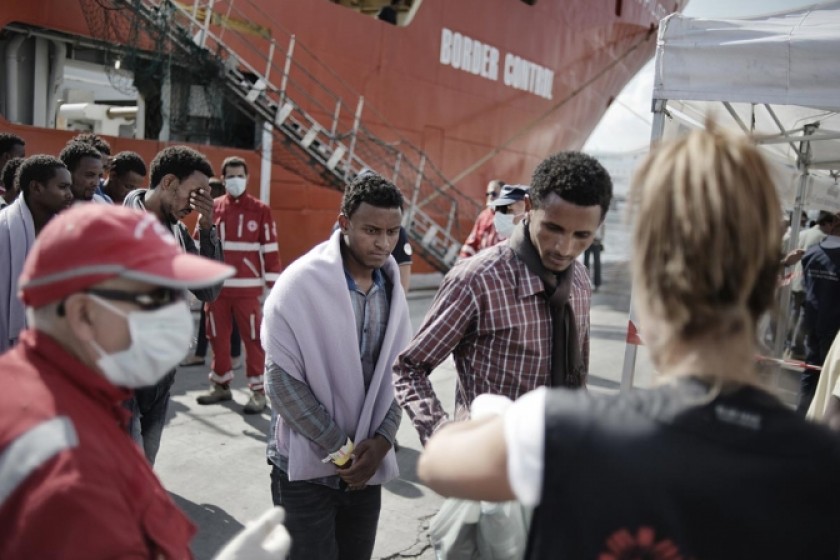
In Sicily, Anti-Mafia Skills Used in the Fight Against People Smugglers
WRITTEN BY EILEEN QUINN
Minutes after being saved by the crew of the rescue vessel Topaz Responder in late November, Mohamed , an asylum seeker from Cote d’Ivoire collapsed on the deck as he recounted the journey that brought him through Africa, into the Mediterranean, and to the edge of a watery death.
“They tortured me. I can’t say what they did to me,” he said. “Am I alive?”
The following morning, after medical treatment on the ship, operated by the Migrant Offshore Aid Station (MOAS), Mohamed pointed to one of the men allegedly responsible for his ordeal: a skinny Libyan in his late twenties.
As Mohamad described his month of imprisonment by smugglers in the Libyan capital, Tripoli, the young man moved toward him, clasps his hand on his shoulder and, seemingly aware he was being exposed, declared: “Me, friend.”
The entreaty didn’t work. As the vessel landed at the Italian port of Vibo Valentia, the Libyan was placed with three other suspected smugglers and taken into custody.
The arrest of the Libyan is typical of how law enforcement has cracked down on African people smuggling rings since the start of the crisis in 2011, which has seen some 600,000 migrants and refugees cross the Central Mediterranean route to Italy in the five years so far. In 2016 alone, over 5,000 died.
Law enforcement has known for the past half-decade that smugglers have used complex networks that reach deep into Africa and Europe. Despite this, those arrested have typically been low-level operatives picked up as they come ashore.
But that is changing. Since mid-2015, Italian authorities have launched a series of operations, named Glauco, that have begun to unveil the structure of violent smuggling networks. In three stages, police and prosecutors based out of Sicily, under the supervision of the National Anti-Mafia Directorate (DNA), have arrested more than 70 smugglers, including those responsible for coordinating and financing operations.
Previously, those arrested on arriving boats were “usually young men, mostly from Libya, who play a minor role in the smuggling market and who pretend to be migrants like all the others,” Carmine Mosca, the deputy chief of the police flying squad in the Sicilian city of Palermo, told OCCRP.
“The big guys back in Africa only send smaller smugglers on board with migrants. This is because they need contacts in Italy to go on smuggling migrants to Central and Northern Europe. But they wouldn’t sacrifice the important ones,” he said.
The Glauco investigations, which have been carried out with the cooperation of countries including Holland and Sweden, have focused on just one part of the vast world of people smugglers: a network of Eritrean and Ethiopian nationals.
Starting from Sicily, the traditional home of the Mafia, investigators have turned to familiar techniques for looking into organized crime. Over a period from May 2015 to July 2016, a combination of phone wiretaps and interviews with landed migrants and suspects led to a gradual understanding of the network’s structure from East Africa, to Italy and Northern Europe.
The picture that emerged was of a coalition of criminal groups, based in each country and drawing on local recruits, that passed human cargo through Africa before taking them by sea.
Eritreans and Ethiopians handle the network – thought to still be in operation – at the source in the Horn of Africa. They work in turn with local gangs in Sudan to bring migrants across the Sahara to Libya. There, Libyans smugglers who control the sea crossing hold the migrants for ransom in warehouses until relatives pay for their releases, often after serious – and sometimes deadly – physical and psychological abuse.
Once migrants reach Italy, the criminals from Eritrea and Ethiopia take control again, often funneling migrants north.
“I spent five months in one of those houses in Tripoli, because I had no money to pay for the journey. The Libyans were torturing us every day, saying that we would never live if we did not pay them,” Somali migrant Osman Jibril said in a United Nations reception center in the Tunisian city of Medenine. “I saw many people die there.”
The successive Glauco operations have revealed details on how money flows in smuggling networks. Costs for passage range from roughly US$ 1,000 to $3,000, using the opaque hawala Islamic brokerage system. The third and most recent phase of Glauco, concluded in July 2016, led to the discovery of the Italian financial center of this smuggling ring: a perfume shop in Rome. In a June raid, police seized over $550,000 in cash as well as a ledger showing the names and addresses of several people who cooperate with the organization, mostly in Africa.
 Videos
Videos Photos
Photos




Write a comment